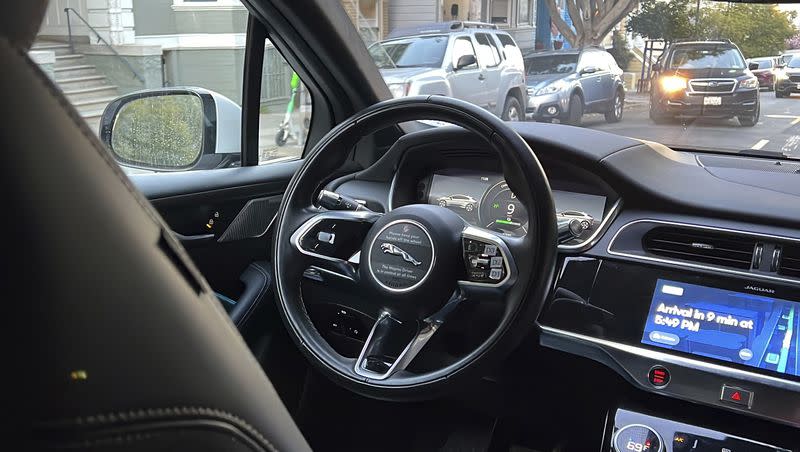Opinion: It’s 2024 — where’s my self-driving car?

If you think the idea of a driverless car is a product of the 21st century, you haven’t heard of Francis P. Houdina.
Actually, it’s likely even his mother hadn’t heard of that name, because he had made it up, a fact that eventually led to an altercation with the better-known escape artist Harry Houdini, but that’s beside the point.
On July 27, 1925, Houdina staged an exhibition in Manhattan to demonstrate his wireless car. The New York Times said the car had a “loose housing around the shaft to the steering wheel,” and police advised him to postpone the stunt, but he forged ahead, anyway.
The newspaper described how the wobbly car, with a remote driver in a car that followed it closely, forced a milk wagon and two trucks onto nearby curbs for safety. It smashed into the fender of a car filled with men who were grinding movie cameras, trying to film the event for posterity. It continued up the road, nearly colliding with a fire engine.
The Times quoted Houdina as saying he planned a trip across the country, once the radio controls had been perfected. Not surprisingly, I can find no record of that ever happening.
Houdina’s invention was not, by modern standards, anything close to an autonomous vehicle, where the car is making the decisions. But, clearly, the idea of a driverless car has been attracting inventors and consumers alike for at least 99 years.
All of which is to say, it’s 2024 already. Where is my driverless car?
Back in 2016, fully 91 years after Houdina’s stunt, Business Insider said, “10 million self-driving cars will be on the road by 2020.”
We’re four years past that and I’m looking around. Nope. Nothing yet.
Well, at least not where I’m standing.
Mark Harper, the British transportation secretary, told BBC Radio 4 last week that success is right around the corner, and it’s not a blind corner.
“This technology exists, it works, and what we’re doing is putting in place the proper legislation so that people can have full confidence in the safety of this technology,” he said.
He even gave us a new date — 2026. That’s when you will be able to sit in the back seat reading your emails while your car takes you to work, provided you aren’t working from home. At least, in Britain. Maybe.
Related
Do you believe it?
I may be writing another version of this column in two years, wondering where my driverless car is. The Society of Automotive Engineers says there are six levels of autonomous driving, from zero to six. Most cars being sold today are, at best, on Level 2, at which the car can handle acceleration and enough steering to keep you in a lane. An attentive driver is still needed for everything else, and to make sure the Level 2 stuff works right.
The website for Semiconductor Engineering said Mercedes-Benz now has Level 3 vehicles, described as being able to do just about everything, but still requiring a driver to be at the ready. That’s a huge step forward. An expert once told me the difference between Levels 2 and 3 was as wide as the Grand Canyon.
A number of driverless taxi fleets have received permission to operate in limited ways in some cities, but a recent accident in San Francisco was a setback.
Level 4 would be the major breakthrough, the level at which a human driver is no longer needed. But that’s a difficult level to achieve.
To get there, the car would have to “see” a construction worker with a “slow” sign and know what it means. The website said the car would have to interpret the hand signals of a police officer directing traffic in an intersection and be able to distinguish that from a regular person in a crosswalk who happens to be waving at a friend.
“Think about driving through downtown Manhattan, Chicago, or San Francisco,” the website quoted David Fritz, vice president of hybrid and virtual systems at Siemens Digital Industries Software, as saying. “The number of unanticipated situations is myriad.”
Cars may begin offering some limited Level 4 technology, such as being able to park themselves. But fully self-driving cars everywhere by 2026?
I don’t want to sound as if I think the car industry will never get there. One of my favorite parts of a biography of the Wright Brothers by David McCullough was his description of how the people of Dayton, Ohio, were so used to making fun of Wilbur and Orville that they couldn’t see the daily flights the brothers were taking right over their heads.
A lot of automation is happening around us already. Self-driving cars are coming, but we should temper our excitement with a measure of realism.
I’d love to have an autonomous car take me to the doctor or to visit a grandchild in my old age, but I’d still like a steering wheel and the option to take control. For one thing, any machine that relies on computers and internet updates could also be hacked.
I don’t want my car to end up like Houdina’s wireless roadster of a century ago, wobbling where I don’t want it to go.

